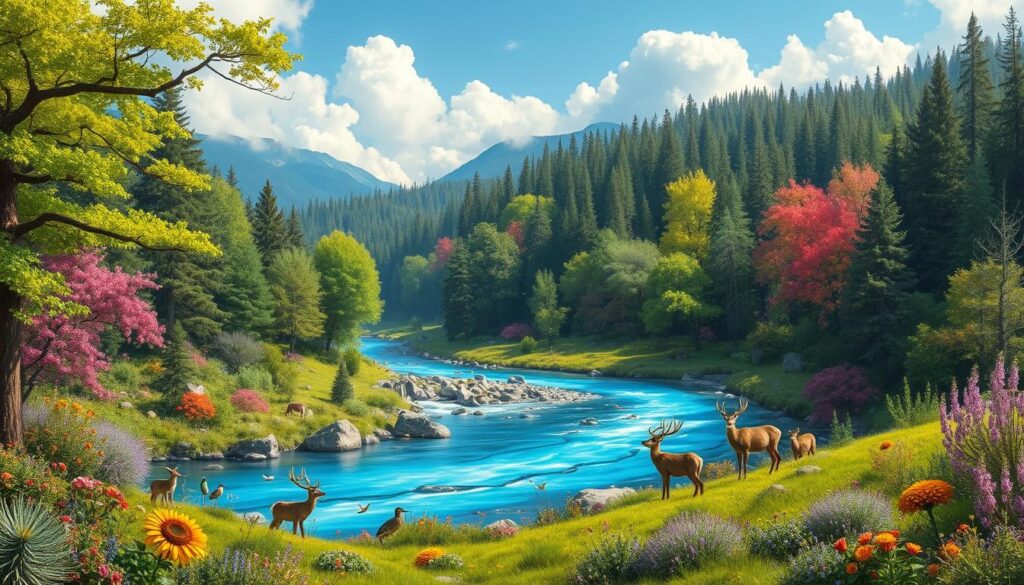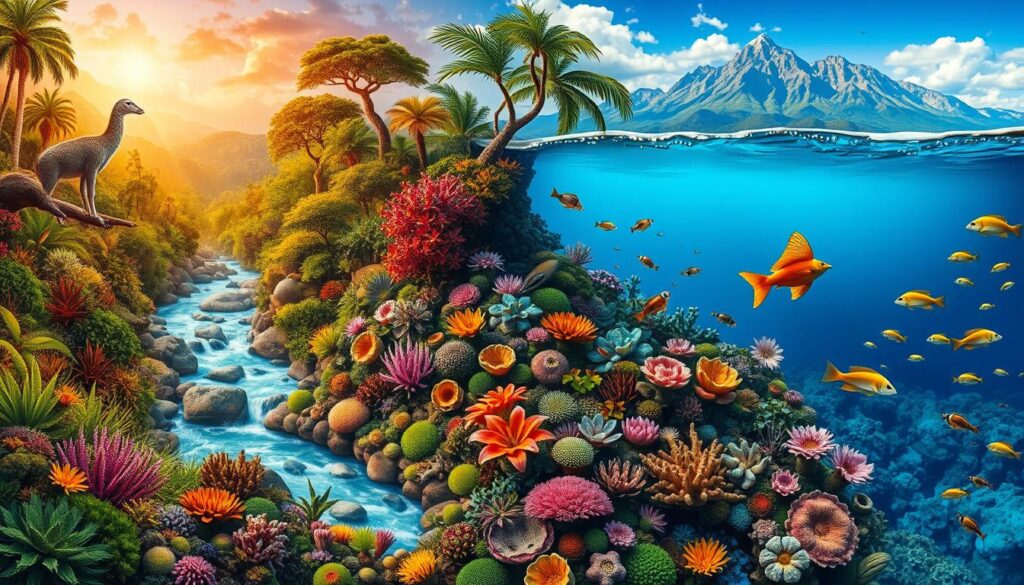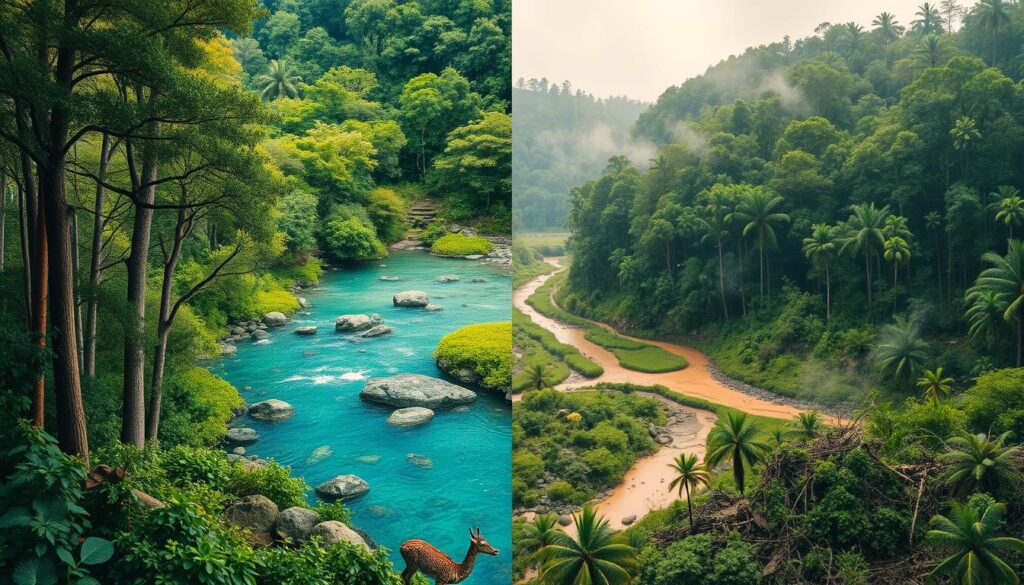
A vibrant, diverse ecosystem showcasing lush green forests, a sparkling blue river, colorful flowers, various wildlife like birds and deer, and a clear sky with fluffy clouds.
Our world is a complex web of life, where different creatures live together in harmony. At the center of this web are ecosystems. These are places where plants, animals, and their surroundings work together to keep life going.
By studying these systems, we can learn how to keep our planet healthy. This knowledge helps us protect the balance that keeps our world thriving.
Key Takeaways
- Ecosystems are complex systems where living organisms and their physical environment interact.
- Understanding the components and interrelationships within ecosystems is crucial for environmental conservation.
- Maintaining biodiversity is essential for preserving the balance and resilience of ecosystems.
- Human activities, such as pollution and habitat destruction, can have significant impacts on the health of ecosystems.
- Ecosystem conservation efforts aim to protect and restore the natural balance of these vital systems.
What is an Ecosystem?
An ecosystem is a complex network of living things like plants, animals, and tiny organisms. It also includes the non-living parts, like air, water, and soil. Together, they create a balance that supports life. Knowing about the different parts and how they work together is key to keeping an ecosystem healthy.
Definition and Key Components
At the core of an ecosystem are two main parts: biotic and abiotic factors. Biotic factors are the living things, like plants and animals. Abiotic factors are the non-living things, such as sunlight and soil. These parts work together, creating a web of interactions that keep the ecosystem running smoothly.
Interrelationships Within an Ecosystem
The living and non-living parts of an ecosystem are connected in many ways. They form food webs and nutrient cycles. These connections help energy flow and nutrients cycle, keeping the ecosystem balanced. If these connections are broken, it can have big effects, showing why it’s vital to protect the ecosystem’s balance.
“An ecosystem is a community of living organisms (plants, animals and microbes) interacting with each other and their physical environment.” – National Park Service
Importance of Ecosystems

A vibrant and diverse ecosystem showcasing a lush forest, flowing river, colorful coral reef, and a mountain range with wildlife harmoniously coexisting; rich textures, vivid colors, and dynamic interactions between flora and fauna, capturing the essence of balance in nature.
Ecosystems are the heart of life on Earth. They offer vital services that keep our planet balanced. These systems, made of living things and their surroundings, are key to resource provision, climate regulation, and water purification.
At the heart of an ecosystem’s role is its support for diverse life. They are habitats for many plants, animals, and microorganisms. Each plays a unique part, showing the importance of biodiversity for a healthy planet.
Ecosystems are crucial for giving us what we need to live. They help grow food, provide water, and offer raw materials. These are vital for our survival and for the economy.
| Ecosystem Service | Importance |
|---|---|
| Resource Provision | Provides food, water, and raw materials essential for human survival and economic growth. |
| Climate Regulation | Plays a vital role in regulating global and local climate patterns, helping to mitigate the effects of climate change. |
| Water Purification | Filters and purifies water, ensuring the availability of clean, safe drinking water for both humans and wildlife. |
Ecosystems also help control the climate. They act as natural carbon sinks and affect rain patterns. By absorbing greenhouse gases, they fight climate change, a major threat to our planet.
In summary, ecosystems are vital. They are the base of life on Earth, offering essential services for our planet’s balance. By protecting these systems, we can secure a future for all.
Biodiversity and Ecosystem
Biodiversity is the rich tapestry of life in our world. It’s key to keeping ecosystems in balance. Each species has its own role, making the web of life strong. When biodiversity is at risk, ecosystems struggle to adapt, leading to big problems.
Role of Biodiversity in Maintaining Balance
Biodiversity is the base for a healthy ecosystem. It brings together species interactions, keeping things balanced. Without it, ecosystem resilience suffers, causing big issues.
The way species work together is vital. Plants, animals, and fungi all have their part. This balance keeps nutrients flowing and ecosystems running smoothly.
But, we’re losing biodiversity fast. More endangered species are appearing. It’s urgent to understand biodiversity’s role in keeping ecosystems stable. We need good conservation plans to protect our planet’s natural treasures.
“Biodiversity is the foundation of the functioning of ecosystems and the delivery of ecosystem services essential for human well-being.” – Intergovernmental Science-Policy Platform on Biodiversity and Ecosystem Services
Threats to Ecosystems

A vibrant forest scene split in two: on one side, healthy trees, diverse wildlife, and clear waters; on the other side, deforestation, pollution, and invasive species overtaking the landscape, showcasing contrasting ecosystems battling threats.
Ecosystems around the world face many threats, often caused by humans. These threats can upset the balance of nature, leading to a loss of biodiversity. This loss affects the essential services that ecosystems provide to us all.
Human Activities Impacting Ecosystems
Habitat destruction is a major threat. As human populations grow, natural habitats are cleared for agriculture, urbanization, and resource extraction. This can severely harm the plants and animals that depend on these habitats.
Pollution is another big threat. Harmful substances like chemicals and waste can contaminate air, water, and soil. This disrupts the natural processes that keep ecosystems healthy. Climate change, caused by human emissions, also impacts ecosystems. It changes weather patterns and leads to more extreme weather.
Overharvesting of resources, like overfishing or logging, can deplete populations. It disrupts the balance of ecosystems. The introduction of invasive species can also harm ecosystems. These non-native species often outcompete native species, leading to a loss of biodiversity.
| Threat | Description |
|---|---|
| Habitat Destruction | The clearing of natural habitats for human activities like agriculture, urbanization, and resource extraction. |
| Pollution | The introduction of harmful substances, such as chemicals, waste, and greenhouse gas emissions, into the environment. |
| Climate Change | The long-term shifts in temperature and precipitation patterns, driven by human-caused emissions. |
| Overharvesting | The depletion of natural resources, such as overfishing or over-logging, beyond sustainable levels. |
| Invasive Species | The introduction of non-native species that outcompete and displace native plants and animals. |
It’s important to understand these threats and take action to protect ecosystems. By addressing these challenges, we can ensure the natural world remains vibrant for future generations.
Ecosystem Conservation Efforts
To fight the threats to ecosystems, many ecosystem conservation efforts have started. These include restoring habitats, using sustainable land management, wildlife conservation programs, and community engagement. Together, we can protect ecosystems and keep our planet healthy.
Habitat restoration is key. It helps fix damaged habitats like wetlands and forests. This work gives plants and animals the homes they need, helping ecosystems thrive.
Sustainable land management is also crucial. It includes practices like sustainable forestry and regenerative agriculture. These methods help reduce our impact on the environment, keeping ecosystems balanced.
Wildlife conservation programs are vital too. They focus on saving endangered species. This is important for the health and stability of ecosystems.
Community engagement is essential. It gets local people involved in caring for their natural resources. This builds a stronger connection to nature and leads to better conservation.
By taking a comprehensive approach to ecosystem conservation, we can ensure a future where nature thrives. Our efforts will help ecosystems support all life, now and in the future.
| Conservation Effort | Description | Key Benefits |
|---|---|---|
| Habitat Restoration | Actively rehabilitating and rebuilding damaged or degraded habitats, such as wetlands, forests, and grasslands. | Provides critical resources and shelter for a wide range of plant and animal species, helping to rebuild the intricate web of life. |
| Sustainable Land Management Practices | Practices such as sustainable forestry, regenerative agriculture, and responsible resource extraction, aimed at minimizing the human impact on the environment. | Protects the delicate balance of ecosystems and ensures their long-term viability. |
| Wildlife Conservation Programs | Focuses on protecting and restoring populations of endangered or threatened species, which are essential to the overall health and stability of their respective ecosystems. | Helps maintain the biodiversity that is crucial to the resilience of natural systems. |
| Community Engagement | Involves local communities in the stewardship of their natural resources, fostering a deeper appreciation and understanding of the importance of these systems. | Leads to more effective and sustainable conservation efforts that benefit both the environment and the people who depend on it. |
By embracing a holistic approach to ecosystem conservation, we can work towards a future where our natural environments are thriving and resilient, capable of supporting the diverse array of life that depends on them. Through collaborative efforts and a commitment to sustainable practices, we can ensure that our ecosystems continue to provide the crucial services and resources that we all depend on.
Conclusion
Ecosystems are complex networks that keep our natural world in balance. They range from lush rainforests to calm lakes. These systems are not just beautiful; they are essential for life on Earth.
Knowing how important ecosystems are and the challenges they face is key. By adopting ecosystem management and conservation actions, we can protect them. This ensures a sustainable future for all.
We can make a difference by working together. By supporting sustainable practices and caring for nature, we help ecosystems grow. Let’s protect these ecosystems for the future. They are the heart of our planet.
Important Point
| NO. | Important Points |
| 1. | About Us |
| 2. | Contact Us |
| 3. | Disclaimer |
| 4. | Privacy Policy |
FAQs of Ecosystem
What is an ecosystem?
An ecosystem is a complex mix of living things and their environment. It includes plants, animals, and tiny organisms. It also has non-living parts like air, water, and soil.
What are the key components of an ecosystem?
An ecosystem has two main parts. Biotic factors are living things. Abiotic factors are non-living things like air, water, and soil.
How are the different components of an ecosystem interrelated?
The parts of an ecosystem work together. They form a balance that supports life. This balance includes food webs, nutrient cycles, and energy flow.
Why are ecosystems important?
Ecosystems are key to life on Earth. They give us food, water, and shelter. They also help regulate the climate, purify water, and cycle nutrients.
What is the role of biodiversity in maintaining ecosystem balance?
Biodiversity is vital for ecosystem balance. It’s the variety of life in an ecosystem. Each species has a role, helping to keep the ecosystem working well.
What are some of the threats facing ecosystems today?
Ecosystems face many threats. These include habitat loss, pollution, climate change, and invasive species. These are often caused by human actions.
What are some ecosystem conservation efforts?
Efforts to save ecosystems include restoring habitats and using land wisely. There are also programs to protect wildlife and engage communities.
